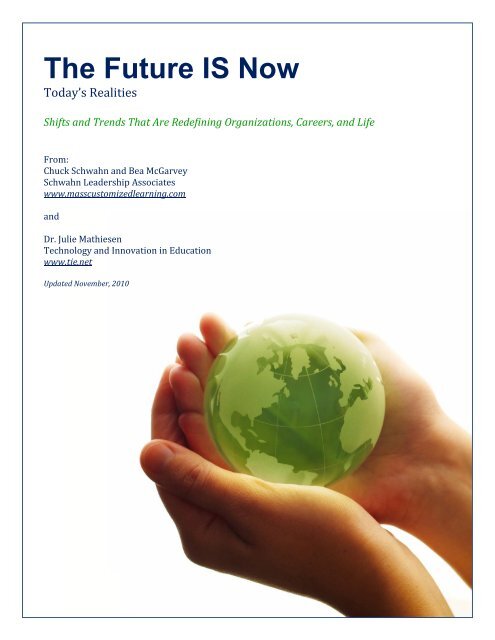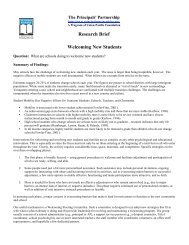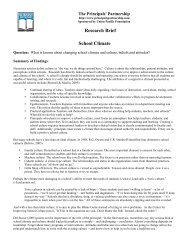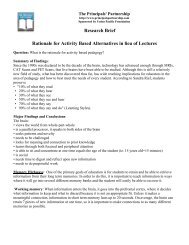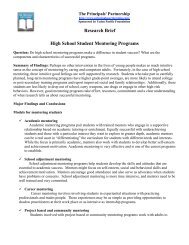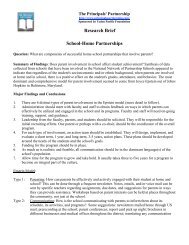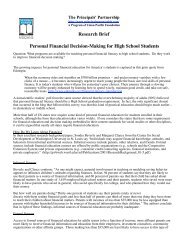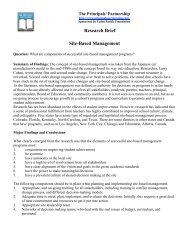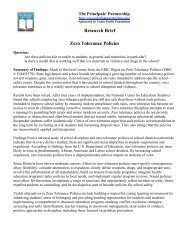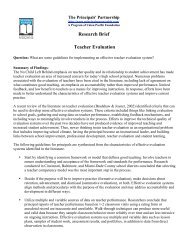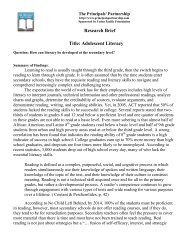The Future Is Now: Today's Realities - Mass Customized Learning
The Future Is Now: Today's Realities - Mass Customized Learning
The Future Is Now: Today's Realities - Mass Customized Learning
You also want an ePaper? Increase the reach of your titles
YUMPU automatically turns print PDFs into web optimized ePapers that Google loves.
<strong>The</strong> <strong>Future</strong> IS <strong>Now</strong><br />
Today’s <strong>Realities</strong><br />
Shifts and Trends That Are Redefining Organizations, Careers, and Life<br />
From:<br />
Chuck Schwahn and Bea McGarvey<br />
Schwahn Leadership Associates<br />
www.masscustomizedlearning.com<br />
and<br />
Dr. Julie Mathiesen<br />
Technology and Innovation in Education<br />
www.tie.net<br />
Updated November, 2010
Key Sources <br />
<strong>The</strong> ideas in this document represent a thematic synthesis of the major information and insights drawn<br />
from a thorough reading of these and many other books. <strong>The</strong>se sources give us the following highlycondensed<br />
picture of the world we all face as learners and performers.<br />
Aburdene, Patricia, Megatrends 2010, 2007<br />
Anderson, C, Free, 2009<br />
Barker, Joel and Scott Erickson, Five Regions of the <strong>Future</strong>, 2005<br />
Brafman, Ori and Rod Beckstrom, <strong>The</strong> Starfish and the Spider, 2006<br />
Bossidy, Larry and Ram Charan, Confronting Reality, 2004<br />
Buckingham, Jane, What’s Next: the experts guide, 2008<br />
Callahan, David, <strong>The</strong> Cheating Culture, 2004<br />
Canton, James, <strong>The</strong> Extreme <strong>Future</strong>, 2006<br />
Christensen, Clayton, Disrupting Class, 2008<br />
Christensen, Clayton, Seeing What’s Next, 2004<br />
Covey, Stephen, <strong>The</strong> 8 th Habit, 2004<br />
Dweck, Carol. Mindset: <strong>The</strong> New Psychology of Success, 2007<br />
Dychtwald, Maddy, Cycles, 2003<br />
Fleming, John and Jim Asplund, Human Sigma, 2007<br />
Friedman, Thomas, <strong>The</strong> World is Flat, 2005<br />
Gardner, Howard, Five Minds For the <strong>Future</strong>, 2006<br />
Gingrich, Newt, Winning the <strong>Future</strong>, 2005<br />
Goldberg, Bernard, Arrogance, 2003<br />
Goleman, Daniel, Social Intelligence, 2006<br />
Greider, William, <strong>The</strong> Soul of Capitalism, 2003<br />
Heath, Chip and Dan Heath, Switch: How to Change Things, 2010<br />
Kelly, F. and T. McCain, Teaching the Digital Generation, 2008<br />
Keys, Ralph, <strong>The</strong> Post-Truth Era, 2004<br />
Ochoa, George, <strong>The</strong> 100 Best Trends, 2006, 2005<br />
Oliver, Richard, What is Transparency, 2004<br />
O’Toole, James and Edward Lawler III, <strong>The</strong> New American Workplace, 2006<br />
Palfrey, J. and U. Glasser, Born Digital, 2009<br />
Pen, Mark, Microtrends, 2007<br />
Peters, Tom, Re-Imagine!, 2003<br />
Pink, Daniel, Drive: <strong>The</strong> Surprising Truth About What Motivates Us, 2009<br />
Pink, Daniel, A Whole New Mind, 2005<br />
Pink, Daniel, Free Agent Nation, 2001<br />
Poscente, Vince, <strong>The</strong> Age of Speed, 2008<br />
Robinson, Ken, <strong>The</strong> Element: How Finding Your Passion Changes Everything, 2009<br />
Schwahn, C. and W. Spady, <strong>Learning</strong> Communities 2.0, 2010<br />
Shirky, C., Here Comes Everybody, 2008<br />
Tapscott, Don, Grown Up Digital, 2008<br />
Tapscott, Don and Anthony Williams, Wikinomics, 2006<br />
Weinberger, David, Everything <strong>Is</strong> Miscellaneous, 2007<br />
Weiner, Edie and Arnold Brown, <strong>Future</strong> Think, 2006<br />
2
Introduction <br />
Welcome to the most recent version of <strong>The</strong> <strong>Future</strong> IS <strong>Now</strong> . . . or “the FIN” as it has come to be known. Feel<br />
free to copy and share it. Give credit when it fits. Thanks to those colleagues who continue to contribute to<br />
the update. Know that we appreciate all suggestions as to what might be added to continuously updated<br />
versions of the FIN.<br />
PURPOSE OF “the FIN”<br />
We all realize that we live in a time of rapid change. With that reality comes the need for leaders, planners,<br />
educators, and virtually everyone, to be future-focused in order to be successful. <strong>The</strong> paradox is that most<br />
of us are so busy working and doing things that we don’t have time to read the fifty+ future oriented books<br />
on which this relatively short report is based. So, the FIN is here to offer “CliffsNotes” on the shifts and<br />
trends that help us to identify the “future conditions” in which we will live and work tomorrow. In short,<br />
read, study, and reflect on the FIN and you will exit with a future focus that will help you ready yourself for<br />
what the world holds for you today and tomorrow.<br />
THE CREATION PROCESS<br />
We started by reading about one hundred futuristic books . . . forty+ of which made our list of “Key<br />
Sources.” From our study and notes, we selected the “shift and trend” topics that we think are the most<br />
relevant to how we will live our lives. We then wrote a short paragraph explaining each of the topics. We<br />
try to be catchy and thought provoking with our “from-to” labels so that they might be “Sticky.” It is<br />
important to note that we identified the major categories of the FIN after we selected the “from-to” topics . .<br />
. we DID NOT identify the eight major categories and then identify the individual topics. So, the individual<br />
topics are the drivers of the FIN document.<br />
HOW OUR UNDERSTANDING OF CHANGE . . . HAS CHANGED<br />
We have come to the realization that “change” is no longer a “trend.” Rather, change is a powerful force that<br />
drives all of today’s trends. Our listing of fifty-plus trends/future conditions is significantly influenced by<br />
our rapidly changing world. <strong>The</strong>refore, don’t expect a paragraph or a category labeled “change.” All of the<br />
FIN topics swim in today’s “change” water.<br />
3
Shifts and Trends Categories <br />
1 - Lifestyle<br />
From Fast Pace to Warp Speed<br />
From Megatrends to Microtrends<br />
From Work-Life Balance to Work-Life Blend<br />
From Linear to Multi-dimensional<br />
From Him/Her the Expert to Me the Chooser<br />
From Broadcasting to Interaction<br />
From Network News to My Yahoo Homepage<br />
From Privacy to Profiling<br />
From Boomers to Seniors<br />
2 - Culture<br />
From Functionality to Design<br />
From Religion to Spirituality<br />
From <strong>The</strong> Commandments to Anything Goes<br />
From Trust to Skepticism<br />
From Civility to Rude<br />
From Right or Wrong to Relative<br />
From Logic to Emotion<br />
From Repair to Replace<br />
3 - <strong>Learning</strong> and Education<br />
From Assembly Line to <strong>Mass</strong> <strong>Customized</strong> <strong>Learning</strong><br />
From Books to Digits<br />
From Answers to Questions<br />
From Engaging Students to Students Engaged<br />
4 - Transformational Technologies<br />
From Change to Disruptive Innovations<br />
From Place to Wireless<br />
From Shelves to Tags<br />
From Filing Cabinets to Trusting Digits<br />
From “Send” to Risk<br />
From Microsoft Programs to Apps<br />
From Program Designers to Here Comes Everybody<br />
From Service Specialists to Do-It-Yourself<br />
From Record Labels to iTunes<br />
From CDs to Playlists<br />
From New York Times to Blogs<br />
From Simon and Schuster to Self-Publishing<br />
5 - Work<br />
From Job Security to “<strong>The</strong> Ride”<br />
From Career Ladder to Career Lattice<br />
From IQ to EQ<br />
From Employment to Free Agent<br />
From Supervision to Empowerment<br />
From Office to Anywhere<br />
From Unions to <strong>The</strong> Creative Class<br />
6 - Businesses and Organizations<br />
From Bureaucracies to Customer-Focus<br />
From Administrative Convenience to <strong>Mass</strong><br />
Customization<br />
From Organizational Charts to Networks<br />
From Headquarters to Leaderless Organizations<br />
From Men to Women<br />
From Secrecy and Strategy to Transparency<br />
From Professional Development to Personal<br />
Development<br />
From Advertising to Customer Evaluations<br />
From Carbon to Green<br />
7 - Government and Politics<br />
From Differing Perspectives to Permanent Biases<br />
From Party of Choice to Independent<br />
From Representation to Arrogance<br />
From Problem Solving to Blame<br />
From Middle Class to Entitlement Class<br />
From Illegal to Undocumented<br />
8 - Global<br />
From Industrial Age to Information Age and Beyond<br />
From World to Global<br />
From Rich and Poor to Super Rich and Destitute<br />
From Universal Values to (Void)<br />
From Power to Terror<br />
From Hunger to Obesity<br />
From United States to China<br />
4
1 – Lifestyle <br />
Fast Pace>>>>>>>>>>Warp Speed<br />
We are living in an age of speed and continuous discovery. Change is constant and the speed of change is<br />
relentlessly on the increase. Rapid and fundamental change is simultaneously impacting our personal<br />
world, our work world, our culture, and our society. Put them all together, and we find that most of us are<br />
living a life that is stressful, sometimes out of control and, for many, very exciting. Some wish the world<br />
would slow down. Well, get over it! It’s just not going to happen.<br />
Megatrends>>>>>>>>>>Microtrends<br />
We are more affluent than ever before, have more lifestyle choices, and the unique choices we make are<br />
segregating us into smaller and smaller niches. One size no longer fits all. When one percent of our<br />
population makes a similar choice (e.g., to homeschool or to be “old new dads”), a microtrend is born and<br />
that group becomes a “niche” that marketers and politicians listen to.<br />
Work-Life Balance>>>>>>>>>>Work-Life Blend<br />
For the knowledge worker, today’s anywhere, anytime technology has blurred the lines between being at<br />
work and being at home with the family. Your Netbook is all you need to transfer your work from the office<br />
to your den. So beware, you can easily be putting in 70+ hours per week at the expense of your family time<br />
if you are not able to blend your responsibilities. Healthy blenders have identified work that is highly<br />
satisfying to them personally and then take the time, at their discretion, to be the parent and partner that<br />
they want to be. Timelines may be blurred, but responsibilities are not.<br />
Linear>>>>>>>>>>Multi-dimensional<br />
We have long valued and honored those left brainers who are able to focus, keep their eye on the goal, do<br />
one thing at a time, and finish their task before taking up the next. Not near so much today. We now boast<br />
about our ability to multitask, to simultaneously keep four balls in the air, and are rewarded for our<br />
creativity more than our convention.<br />
Him/Her the Expert>>>>>>>>>>Me the Chooser<br />
<strong>The</strong>re once were recognized and rewarded experts; those who knew more about one thing than anyone.<br />
We listened to them. We bought the stocks they suggested, raised our children as they advised, bought the<br />
car that they endorsed. Today we are more likely to trust the “Wisdom of the Crowd.” We buy cameras<br />
based on the rankings of average Joes who are real users, buy the car that makes us look good behind the<br />
wheel, and purchase the book that others who bought this book also purchased.<br />
Broadcasting>>>>>>>>>>Interaction<br />
Just yesterday (Oct. 2010) it was announced that ABC, NBC, and CBS news programs had lost nearly one<br />
million viewers over the past year. About the same as last year . . . and the year before that. Think anything<br />
will change over the next year Doubt it! All the while, Madden football continues to grow more popular<br />
and profitable, and people get their news from their Yahoo Homepage where they are able to “comment” on<br />
the story. People today (and especially NetGeners) tend not to sit quietly and listen. <strong>The</strong>y go where they<br />
can be part of the action.<br />
Network News>>>>>>>>>>My Yahoo Homepage<br />
Would you like 22 minutes of news chosen by Brian Williams along with 8 minutes of commercials about<br />
medications and their side effects in the 30 minutes you set aside to catch up on the events of the day . . . or<br />
would you like to create a My Yahoo Homepage that allows you to identify the news sources you<br />
trust/enjoy, read the news that is of interest to you, avoid commercials except those of interest, and<br />
consume all the news you want/need in 15 minutes Gee, . . . let me think!<br />
5
Privacy>>>>>>>>>>Profiling<br />
Today’s Internet-driven social networks allow people and organizations to know more about you than you<br />
might like. Very large piles of raw data can be “mined” to make predictions about your lifestyle, buying<br />
habits, vulnerabilities, or whatever. Barcodes, credit cards, e-mails, Internet habits, and just plain<br />
snooping, when combined, can create a detailed profile on nearly anyone. A technology known as Radio<br />
Frequency Identification makes it possible for Walmart to track a single lipstick tube or a toaster – how it<br />
got there, who bought it, and where it is now. <strong>The</strong> good news is that profiling has the potential to serve you<br />
better. Amazon.com can make better recommendations when it has your profile . . . as can doctors,<br />
teachers, or anyone who is bent on doing you good. You may one day want to have your very own barcode<br />
to ensure that everyone can serve you better. Bottom line, however . . . if someone wants to know<br />
something about you, has dollars and is persistent, they will probably find it. “Big brother” might be<br />
watching and, just because you’re paranoid, doesn’t mean that they’re not out to get you!<br />
Boomers>>>>>>>>>>Seniors<br />
Demographics are real numbers, factual, hard to argue with. <strong>The</strong> famous Boomer generation is becoming<br />
“seniors” . . . but not the kind of seniors your grandma was. <strong>The</strong>y are healthy, expect to live longer and, for<br />
most, believe that anything is still possible. And there are lots of them . . . who will create new markets,<br />
require services, and depend on a shrinking number of wage earners to keep Social Security and Medicare<br />
solvent.<br />
6
2 – Culture <br />
Functionality>>>>>>>>>>Design<br />
Competing in today’s marketplace isn’t for sissies. You must produce with quality, speed, and uniqueness…<br />
or quickly become a commodity, selling your product or service only because it’s cheapest. But today, add<br />
another layer to customer expectations. We want it quick, we want it to work, we want to be the first on<br />
our block to have it… AND, we want it to be “designed” with class and elegance. Think Apple Inc. and the<br />
iPad, iPhone, and MacBook Air. Design adds “looks good” and “feels good” to the “value added” equation.<br />
Design You know it when you see it or feel it!<br />
Religion>>>>>>>>>>Spirituality<br />
While the world struggles with religious indifference on one hand and religious fanaticism on the other, the<br />
impulse of human beings to connect with the spiritual is in evidence everywhere. Spiritual supplements<br />
have become big business . . . from books to prayer beads to meditation benches. Many are searching for<br />
something higher, deeper, greater and more profound than themselves, and something which transcends<br />
the boundaries of traditional religions. An oversimplification for sure, but it would appear that the blue<br />
states are about spirituality while the red states are about religion.<br />
<strong>The</strong> Commandments>>>>>>>>>>Anything Goes<br />
<strong>The</strong> pop culture of the U.S., led by the entertainment industry and the media and supported by willing<br />
consumers, is rapidly becoming an “anything goes” culture. It is a mark of honor for the entertainment<br />
industry to “push the envelope” of sex, violence, and language. Red states and blue states and recent<br />
national elections reflect this conflict. One has only to watch a rerun of Archie, Andy, or Mary Tyler Moore<br />
and then watch a promo for Desperate Housewives to see and understand the conflict. <strong>The</strong> first amendment<br />
rights of adults consistently and arbitrarily put children and parenting in jeopardy. <strong>The</strong> influence of<br />
America’s “slippery slope” culture is multiplied by the fact that the U.S. is by far the world’s largest<br />
distributor of contemporary culture. A continued conflict between the “anything goes” culture of the U.S.<br />
and the more conservative religions and cultures of much of the world appears to be inevitable and<br />
troublesome.<br />
Trust>>>>>>>>>>Skepticism<br />
When there were few news sources, few businesses, and some would say in “the good old days,” we tended<br />
to believe most anything that was in print and appeared professional. And with reason; there were<br />
hucksters then for sure, but honesty has taken a big hit in our recent past. “Buyer beware” is now<br />
engrained in our psyche . . . we don’t have to be told or even think about it. Skepticism is our default<br />
setting. “Trust everyone but cut the cards” is the new rule.<br />
Civility>>>>>>>>>>Rudeness<br />
Talk show hosts and guests MUST talk over others on the show or they will never get the mic . . . or another<br />
opportunity to be a “guest.” We have come to accept this type of rudeness as natural from angry drivers,<br />
irate customers, mean bosses, exchanges between parents and children, etc., etc. In fairness, rude people<br />
are very outnumbered by the civil, but what tends to be rewarded, what we notice and seem to imitate, are<br />
those in-your-face trash talkers that dominate professional sports. Role models for our youth<br />
Right or Wrong>>>>>>>>>>Relative<br />
Today’s society has few “rights” and “wrongs.” Individuals can and do present a rationale for their way of<br />
thinking, their way of acting, and then go about their business with little pushback from public norms.<br />
Decisions and behaviors are considered situational and relative. Although norms continue to exist, acting<br />
outside of these norms is commonplace and accepted. End result: freedom to “do your thing,” and few rules<br />
to guide thinking, decisions, and actions.<br />
7
Logic>>>>>>>>>>Emotion<br />
After you read an article or listen to a speaker who takes a strong stand on an issue, it is healthy to take the<br />
time to analyze the argument. <strong>The</strong> question, the focus of the reflection: “<strong>Is</strong> the argument and the ultimate<br />
position taken by the author based on a logical, rationale argument, one that is based on data, research,<br />
accepted theory, and/or history” Or was the position taken by the author accepted or rejected based upon<br />
his/her charisma, speaking ability, feelings, and emotions Our culture today allows many to commit<br />
“Crimes Against Logic” when selling products or political positions.<br />
Repair>>>>>>>>>>Replace<br />
<strong>The</strong> quality paradigm of the 90s made everything last longer . . . well, almost everything. Production<br />
techniques have made them cheaper. Technological complexities have made them hard to repair. Repair<br />
shops are mostly out of business. When my digital camera, that does everything short of sorting socks,<br />
develops a small flaw, I am told by the retailer that it is “cheaper to buy a new one.” <strong>The</strong> new model, by the<br />
way, has more features that I probably will never use . . . and will make the new model even more unlikely<br />
to ever be repaired.<br />
8
3 - <strong>Learning</strong> and Education <br />
Assembly Line>>>>>>>>>><strong>Mass</strong> <strong>Customized</strong> <strong>Learning</strong><br />
<strong>The</strong> Industrial Age brought us mass production. <strong>The</strong> Information Age brought us mass customization.<br />
Everyone is mass customizing. We have come to expect that the products we buy and the services we<br />
subscribe to are personalized to US. Starbucks does it. iTunes does it. Google does it. Your gym does it.<br />
Your grocery store does it. Everybody does it. Except for K-12 education! Education continues to offer<br />
learning opportunities in an assembly line fashion. <strong>The</strong> “belt” moves kids from grade 1 through grade 12,<br />
where time is the constant and learning is the variable. Given what we know about learners and learning, it<br />
is INEVITABLE that education will adopt some form of mass customization.<br />
Books>>>>>>>>>>Digits<br />
What is a book anyway Does a series of ten related and sequenced essays require a “cover” to be a book<br />
Does it have to be able to sit on a shelf to be a “book” We can’t think of another industry that has been so<br />
quickly turned on its head. Computers, Google, Wikipedia, Amazon.com, e-readers, and thumb drives are<br />
quickly, and not so quietly, replacing textbooks and libraries. <strong>The</strong> question asked five years ago was “can<br />
we afford to buy computers for every student” Today we are hearing “why do we continue to buy all of<br />
those expensive books when one iPad brings access to the entire world of information”<br />
Answers>>>>>>>>>>Questions<br />
Answers are good, helpful, and important when we are dealing with problems of the past. <strong>The</strong>se answers<br />
had their day, but if the problem that created the answer can be “Googled” and an agreed-upon answer is<br />
returned, their day is quite finished. But thoughtful “what if” questions are what take us to the future, to<br />
solutions for present and future opportunities. “What if” questions tend to contain the “vision” of the asker<br />
. . . and it is that vision that moves the discussion, the innovation, and the potential breakthrough forward.<br />
Engaging Students>>>>>>>>>>Students Engaged<br />
Engaged learners are achievers, much as engaged workers are producers. On that we can agree. But what<br />
causes learners and workers to be engaged is not so easily agreed upon. <strong>Is</strong> it extrinsic rewards and<br />
punishments such as grades, class rank, and the car on Saturday night Or is engagement better fostered<br />
through the intrinsic rewards of relevance, meaning, challenge, achievement, and success Extrinsic<br />
motivators may help the system to “engage students in their learning,” but intrinsic motivators help<br />
students to “be engaged in their learning.” <strong>The</strong> difference in the phrases is subtle, but the difference in the<br />
degree of engagement is striking. Recent research and accepted theory is coming down heavily on the side<br />
of intrinsic motivation.<br />
9
4 - Transformational Technologies <br />
Change>>>>>>>>>>Disruptive Innovations<br />
Change used to be something that we could see coming, something we could watch. Montgomery Ward, the<br />
once retail giant, took a couple of decades to be done in by the retailing innovations of Sam Walton. Travel<br />
agents fought the tide of the personal computer, the Internet, and the do-it-yourself movement for years.<br />
Today it doesn’t take that long to “do in” a business or a complete industry. Disruptive technological<br />
innovations, society’s changing norms and expectations, and the “mass customization” movement have<br />
taken down Blockbuster and crippled Barnes & Noble in a matter of months. Today’s technological<br />
breakthrough innovations have placed in jeopardy any business or industry that sits between the creator of<br />
products or services and the end user of those products or services. Does anyone see self-publishing about<br />
to “disrupt” the publishing industry<br />
Place >>>>>>>>>>Wireless<br />
“Place” used to be an important determiner of what we were doing. Certain things were done in certain<br />
places. Offices and factories were for work, theaters were for being entertained, our homes were for family<br />
activities, etc. Computers and the Internet significantly changed all of that. <strong>The</strong> technology of ten years ago<br />
gave us the flexibility to do things in “different/alternative places.” But when “wireless” was added to that<br />
technology, “place” ceased to be a factor. Anyone can do anything from any place at any time. It is<br />
interesting to see how third-world countries have leapfrogged the old communications infrastructure costs<br />
by going from almost no communication with the rest of the world to cell phones and being connected . . .<br />
globally.<br />
Shelves>>>>>>>>>>>Tags<br />
Grocery stores have things in their places . . . as do closets and silverware drawers. <strong>The</strong> Dewey Decimal<br />
System went one level better with the card catalog . . . you could find a book from a title, author, or subject<br />
card in the card catalog. But today, Google and Bing are organizing the world’s information . . . and putting<br />
you in charge of how it will be organized for your own particular use. Flickr is doing the same thing for<br />
photos, and Apple is doing it with iTunes and playlists. It used to be that authorities would tell us how<br />
things should be organized – top down. Today, information is “tagged” and bar-coded, and computers<br />
allow us to tell the authors and experts how we want it organized – bottom up. Read Everything is<br />
Miscellaneous by Weinberger for an understanding of how “level three organizing” works and how it is<br />
changing who is in control.<br />
Filing Cabinets>>>>>>>>>>Trusting Digits<br />
Digital immigrants took some time to trust digits. For years we continued to make hard copies of anything<br />
we “might really need some time.” Paperless offices, though visualized, were not happening. But today we<br />
have come to trust digits, hard drives, and especially our “backup” systems. Copy machines have moved<br />
from downtown to our offices and are seldom used except for printing boarding passes. Photo albums are<br />
accessed from “My Pictures” or iPhoto, music is accessed through iTunes, books are accessed through<br />
Kindle, office correspondence and reports are accessed through “Word,” students bring their homework to<br />
school on thumb drives, and Google provides the world’s information via your Netbook or iPad. What are<br />
we going to do with all of that shelf space<br />
“Send”>>>>>>>>>>>Risk<br />
We have gone from “let’s make a copy of that in case we might need it someday,” to “once you have hit the<br />
“send” button, it will be there forever.” Before you hit that “send” button, you are encouraged to ask<br />
yourself . . . “Would I want Mom to see this Could I handle this being on the front page of the NYT What<br />
could O’Reilly do with this Could this possibly be ammo for a prosecuting attorney” Not to mention my<br />
wife! (Or husband, of course.)<br />
10
Microsoft Programs>>>>>>>>>>Apps<br />
New technology has a way of changing things more than we first realize. <strong>The</strong> iPod didn’t just change how<br />
we listened to music; along with iTunes, it changed the music industry. Amazon.com didn’t just change the<br />
way we purchased books, it changed the way we buy everything. <strong>The</strong> iPhone didn’t just change our<br />
concept of smartphones, but their “apps” removed the limits of preinstalled programs and features. It’s<br />
nearly unbelievable what we can add to our wireless devices for free or for small change. So this<br />
paragraph is not just about apps, but about the far reaches of technological innovations. We need to look<br />
beyond the initial market for the new new thing.<br />
Program Designers>>>>>>>>>>Here Comes Everybody<br />
Linux and Wikipedia are the poster children for complex, highly successful, and FREE programs that are<br />
being created by volunteers and made available to everyone. Clay Shirky, author of Here Comes Everybody,<br />
tells us that “we are living in the middle of a remarkable increase in our ability to share, to cooperate with<br />
one another and to take collective action, all outside the framework of traditional institutions and<br />
organizations.” Think what this could mean to learners if education’s curriculum directors and teachers<br />
did a “wikilearning” focused on curriculum and instruction that went far beyond “state standards.”<br />
Service Specialists>>>>>>>>>>Do-It-Yourself<br />
We still need to call the plumber when we can’t stop that leak, or when the stool is plugged and our small<br />
makeshift rooter hasn’t solved the problem, but more and more we have surprisingly become a do-ityourself<br />
society. Lowes and Home Depot’s business model is based on this unlikely turn of events. Bing<br />
and Google have become free sources for solving technology problems that frequently are superior to the<br />
“help” link that is supplied by the seller of the program. Tie the do-it-yourself movement to the “throwaway<br />
society,” and today’s repairman is as lonely as the old dude in those Maytag commercials of<br />
yesteryear.<br />
Record Labels>>>>>>>>>>iTunes<br />
We include this “from-to” in our listing because it is an excellent example of how quickly and completely<br />
technology can significantly change an industry. Imagine the panic the first time a recording label<br />
executive heard a song downloaded onto an iPod! Or the first time the CEO of Barnes & Noble heard of<br />
Kindle. But “disruptive innovation” goes far beyond entertainment and media. Everyone in business needs<br />
to be ready to be blindsided by new technology . . . or to be the one who is doing the blindsiding. Success is<br />
transitory. Today, as we write this paragraph, it was announced that Apple, Inc. might surpass Exxon Mobil<br />
as the #1 market capitalization company in the world. Gee, isn’t this the struggling company that fired its<br />
creator Steve Jobs and then hired him back about 10 years ago<br />
CDs>>>>>>>>>>Playlists<br />
This “from-to” is more about power than about music. Technology tends to move power from the CEO, the<br />
corporation, and the establishment to the visionary/creator, the startup company, and the customer. This<br />
power shift is not a one-industry phenomenon. Think network news and bloggers, newspapers and news<br />
homepages, car dealers and online car price comparisons, etc., etc. Recording studio execs who once<br />
identified the songs that would go on a new album now are more directed by the singers themselves; and<br />
the customers who once purchased ten songs to get the one they wanted now create their own playlist and<br />
purchase only the songs on “their” list.<br />
11
New York Times>>>>>>>>>>Blogs<br />
Newspapers and news magazines are in trouble. Readership continues to go down about 10% per year and<br />
the accompanying lack of revenue has caused major layoffs and potential bankruptcies. <strong>The</strong>y face two<br />
simultaneous enemies and are losing their readers and their shirts. One, more than half of the public<br />
believes that major news organization like the NYT and Newsweek do not cover events objectively, that<br />
they are biased to the left, and have stopped reading them. Two, bloggers have proven to be strong<br />
competitors. <strong>The</strong>y too, of course, are biased, but the reader gets to select the bias that is synced with<br />
his/her personal bias. And it doesn’t seem as though the main media “gets it!”<br />
Simon and Schuster>>>>>>>>>>Self-Publishing<br />
A power shift is also occurring in the book publishing industry. Rejection letters from publishers rank high<br />
on the list of esteem crushers. We have experienced it! Publishers (many of them, anyway) come across as<br />
arrogant judges with EQs barely at the “trainable” level. Look to the horizon and Lulu, CreateSpace and a<br />
dozen other self-publishers who actually treat would-be authors as customers are coming. Furthermore,<br />
publishers believe themselves generous when they share 12% of the selling price of the book. Selfpublishing<br />
can create a business model that rewards authors with 50% or more of the price of the book.<br />
12
5 – Work <br />
Job Security>>>>>>>>>>“<strong>The</strong> Ride”<br />
<strong>The</strong> economic times of 2009 and 2010 have made it perfectly clear that “job security” is an outdated<br />
concept. Being prepared for only one job, one role, is akin to playing Russian Roulette. <strong>The</strong> new term,<br />
“jobless security” actually makes perfect sense today. Those able to stay on their feet when their old job is<br />
being done in China or by a computer chip, are those who have continued to learn, grow, and to be ready<br />
for work with that new “startup.” Today’s “career ride,” although frequently dangerous, is never boring.<br />
When you are 65 and asked by a member of your golfing foursome, “well, what did you do,” the answer will<br />
not be a one-liner that can be communicated between shots . . . it will have to wait until the 19 th hole.<br />
Career ladder>>>>>>>>>>Career lattice<br />
A ladder and a lattice – a good visual analogy to help understand “getting ahead at work” today.<br />
Organizational charts have flattened; old-time opportunities for “moving up the corporate ladder” are few.<br />
Old, well-established companies and entire industries are being replaced by instantly successful innovators<br />
that have found a new and better way of providing products and services that today’s society wants and<br />
demands. Careers today move sideways more often than up . . . and one can expect both ups and downs on<br />
that “career lattice.” Bea and Chuck are no longer administrators dealing with curriculum and instruction.<br />
We are now consultants who focus on leadership and future-focusing. And, we are beginning to dabble a<br />
bit in writing. We can be charted on the lattice.<br />
IQ>>>>>>>>>>EQ<br />
<strong>The</strong> work of Daniel Goleman has helped us to understand the value of the “emotional quotient” as well as<br />
the “intellectual quotient.” Both “Qs” are still important, but for most of today’s successful, the need for a<br />
high EQ surpasses the need for a high IQ. (‘Tis nice to know that the two Qs are not mutually exclusive.)<br />
Goleman’s widely accepted research indicates that EQ is twice as critical as IQ to the success of people (on<br />
the job and off), and that the higher one goes in organizations the more important it becomes, to the point<br />
that the successful leaders of organizations run almost totally on EQ.<br />
Employment>>>>>>>>>>Free Agent<br />
Lifetime loyalty to a single organization is a thing of the past, and the American entrepreneurial spirit is<br />
blossoming as individuals choose to go it on their own. Conservative estimates are that 35 million<br />
Americans are Free Agents today, selling services, expertise, and advice to multiple clients. Free Agents<br />
come in the forms of temps, consultants, freelancers, proprietors of home-based businesses, and many<br />
other self-selected labels. <strong>The</strong>y are trading security for freedom, opportunity, authenticity, and<br />
accountability. <strong>The</strong>y move from job security to “jobless security” by making every day count, and<br />
embodying quality, entrepreneurship, passion and professionalism at their best. Women and Generation<br />
Xers are leading the charge. <strong>The</strong> good news is that Free Agents can set their own schedules . . . the bad<br />
news is that many are working 24/7.<br />
Supervision>>>>>>>>>>Empowerment<br />
Empowered people produce! It works! It’s not a buzzword! It’s here to stay! Empowering qualified<br />
people to have more control over their work is both morally right and financially profitable.<br />
Empowerment honors the intrinsic motivation of people to use their expertise to best advantage and gives<br />
them a direct stake in achieving both personal and organizational success. Empowerment works best when<br />
employees deeply identify with organizational purpose, have a clear vision of where the organization wants<br />
to go, have a strong commitment to getting there, have the information, capabilities, and tools to get there,<br />
and receive the organizational support necessary for accomplishing its vision. Empowerment is even more<br />
moral and more effective when the empowered get a “piece of the action.”<br />
13
Office>>>>>>>>>>Anywhere<br />
Work has moved from heavy lifting to forklifts . . . from running machines to talking to machines . . . from<br />
people to robots . . . from 8 to 5 to anytime and anywhere . . . from the office to ATT Wireless at a corner<br />
table at Starbucks. Through the power of communication technologies, more and more people are working<br />
outside of the conventional forty hours per week job schedule and structure. Flexible schedules, job<br />
sharing, teaming arrangements, and offsite locations place a premium on worker autonomy, responsibility,<br />
and the ability to “get the job done well” with minimum structure and supervision. And the research on<br />
this indicates that most of these “anywhere, anytime” employees tend to be more productive than those at<br />
the office. <strong>The</strong> 4-Hour Workweek, a NY Times bestseller, written by 30-year old Timothy Ferris, is a creative<br />
and fun read if you are ready to explore a new lifestyle.<br />
Unions>>>>>>>>>><strong>The</strong> Creative Class<br />
In this day of frequent career change, power has shifted from unions to the talented, creative, and<br />
responsible employees who love challenge. <strong>The</strong>y are in demand. Treat them with respect, provide the<br />
flexibility they want, give them control, ensure that they find meaning in their work . . . or lose them. Lose<br />
them to another company or to the “free agent” entrepreneur pool that continues to grow in this age of<br />
talent and creativity. Meanwhile, unions once so important to workers and our society in the Industrial<br />
Age, today find their power and their demands choking businesses and industries that must compete<br />
globally.<br />
14
6 - Business and Organizations <br />
Bureaucracies>>>>>>>>>>Customer Focus<br />
We have moved from a business world in which companies controlled consumers to one in which<br />
consumers control companies. Worldwide comparative shopping requires only a few clicks. If you expect<br />
to sell it, it needs to have value for your customers, and they know it! Today’s self-directed consumers have<br />
countless options, unashamedly vote with their feet and pocketbooks, openly demand choices in products<br />
and services that are customized to their needs and tastes, want things now, not tomorrow or next week,<br />
expect quality and value – and the price to go down, and willingly return things that don’t suit them.<br />
Moreover, whether satisfied or not, they tell their friends – over the Internet. Even the rich expect and take<br />
pride in getting a “good deal.” Guess the old saying that the “customer is always right,” is more true today<br />
than ever.<br />
Administrative Convenience>>>>>>>>>><strong>Mass</strong> Customization<br />
Technology (think computers, tablets, smartphones, and the Internet) has changed nearly every aspect of<br />
our world and our life. “<strong>Mass</strong> Customization,” a term that slipped into the futures literature a few years<br />
ago, has silently changed our expectations for products and services. We, the consumers, no longer want<br />
one “off of the shelf,” but rather one tailored to our needs and wants. Back when, when Dell allowed us to<br />
design our own computer and deliver it in two days, we recognized how they changed the computer<br />
market. <strong>Now</strong>, new forms of customization have become the norm, they happen daily, and we hardly notice<br />
them. One of the most recent to affect your humble authors is self-publishing. We get to do it our way!<br />
Who needs rejection letters<br />
Organizational Charts>>>>>>>>>>Networks<br />
Communications technologies have made it possible for a single supervisor to double or triple the number<br />
of employees that he/she can effectively monitor and supervise. Consequently, fewer levels of<br />
management are required and organizational charts have been flattened. At the same time, the nature of<br />
work changed as we moved from the assembly line to the age of the “knowledge worker.” Solutions for<br />
today’s more complex “knowledge work” require teams of experts. <strong>The</strong>se two new realities, in<br />
combination, have moved organizational structures from a rigid chain of command to a more flexible<br />
system of teams and networks. Organizational charts have moved from pyramids to pancakes.<br />
Headquarters>>>>>>>>>>Leaderless Organizations<br />
<strong>The</strong> world . . . and especially governments and industries . . . are learning of the unstoppable power of<br />
decentralized leaderless organizations. <strong>The</strong> Internet has made it possible for like-minded individuals from<br />
anywhere in the world to meet in cyberspace and form powerful movements . . . for good or for bad,<br />
without ever creating a centralized organization that can be confronted. <strong>The</strong>se movements are usually<br />
created by a charismatic leader who then moves to the background, leaving a leaderless movement<br />
maintained by loose networks and driven by a strong and rigid ideology. Al Qaeda, PETA, the group(s)<br />
against globalization, and those illegally sharing copyrighted music files are examples. When attacked,<br />
these decentralized organizations tend to become even more open and decentralized . . . and very difficult<br />
to confront or defeat. <strong>The</strong> Starfish and the Spider by Brafman and Beckstrom effectively describes this<br />
leadership/organizational phenomenon . . . an important read for all of us.<br />
15
Men>>>>>>>>>>Women<br />
Despite the enormous pressures women in the labor market face in handling child-rearing and other<br />
household management responsibilities, a large proportion of new businesses are owned and operated by<br />
women. Women not only serve as a big source of employment, they represent a new, congenial,<br />
relationship-oriented approach to leadership that balances the command/control approach so widely<br />
accepted in traditional male-dominated firms. According to Tom Peters, “Women get it!” <strong>The</strong>y get<br />
relationships, teaming, cooperation, networking, etc. when organizations need, well . . . relationships,<br />
teaming, cooperation, networking, etc. For more on women in leadership, look for Peters’ Re-Imagine!,<br />
where Tom probably gets to the point of being “sexist” . . . against men!<br />
Secrecy and Strategy>>>>>>>>>>Transparency<br />
<strong>The</strong> society-wide demand for greater organizational openness and accountability is reinforcing a major<br />
trend in effective organizational change and adaptability. Namely, honest and open communication is a key<br />
to effective leadership performance, organizational credibility, employee trust and motivation, and<br />
organizational innovation and productivity. <strong>The</strong> great demand by both consumers and employees for<br />
“want to know” information is supported by the technological capacity to make it available at the touch of a<br />
keypad. Information technology has made it nearly impossible to hide anything from anyone. <strong>The</strong>re seems<br />
to be a visual, auditory, and/or written record of everything . . . from old nude pictures of today’s stars to<br />
the kindergarten records of presidential candidates.<br />
Professional Development>>>>>>>>>>Personal Development<br />
Who you are is how you relate, how you work, and how you lead. Your core shows itself in everything you<br />
think, say, and do. In today’s world where EQ (emotional quotient) is more important than IQ, professional<br />
development is ultimately personal development. In short, if you wish to improve any aspect of your life,<br />
look to your core for improving your health, speeding your development, and improving your<br />
opportunities for success.<br />
Advertising>>>>>>>>>>Customer Evaluations<br />
Who would you trust to advise you . . . the marketing department of HP or the reviews of 150 people who<br />
have purchased the printer you are considering, the publisher’s review of Inevitable: <strong>Mass</strong> <strong>Customized</strong><br />
<strong>Learning</strong> or the evaluations of 60 people who have purchased and read the book. We now not only have<br />
access to the reviews of real users, but reviews of the reviewers . . . like in “56 out of 58 people found this<br />
review helpful.”<br />
Carbon>>>>>>>>>>Green<br />
<strong>The</strong> global warming debate climate change debate may not be over, but you wouldn’t know it from the<br />
number of businesses and organizations that are boasting of their commitment to “going green.” Expect<br />
things to happen. Customers are influenced by companies and communities that are environmentally<br />
friendly. Add another “inconvenient truth” . . . values don’t typically change behaviors . . . behaviors<br />
actually change when there is a financial incentive to do what we say we value.<br />
16
7 - Government and Politics <br />
Differing Perspectives >>>>>>>>>>Permanent Biases<br />
Political biases seem to be are more extreme and permanently rigid than ever before. From the liberal . . .<br />
George Bush IS dumb, he lied about WMDs, and his eight years nearly ruined our country. From the<br />
conservative . . . Obama is a socialist, taking us in the wrong direction, and can’t speak without his<br />
teleprompter. It is rare to hear anyone saying good things, even one good thing, about the values and<br />
strengths of the opposing candidate or party. Enter the independent who is tired of this hateful, biased, and<br />
loud rhetoric.<br />
Party of Choice>>>>>>>>>>Independent<br />
Irony of ironies . . . it is the independent unbiased thinker, not the true believer who is electing our political<br />
leaders today. <strong>The</strong> rigid 40% on each side of the middle slug it out with negative ads, personal attacks, and<br />
one-dimensional voting records while it takes only the 5 to 10% of independent thinkers and decision<br />
makers moving in one direction to elect a candidate.<br />
Representation>>>>>>>>>>Arrogance<br />
<strong>The</strong>re was a time when we could expect those we elected to represent the constituency from whence they<br />
came. But the day after being elected now appears to be the first day of raising $$$ for the next election.<br />
Career politicians hold the powerful positions, and their incumbency perks make them hard to defeat. Our<br />
country is angry, and much of the anger can be placed on the arrogance of those in power. Can you believe<br />
the arrogance of our elected officials passing major laws that they themselves do not have to follow Think<br />
health care, social security, retirement benefits, etc.<br />
Problem Solving>>>>>>>>>>Blame<br />
<strong>The</strong>re may have been a time when our representatives focused on solving problems . . . but our memories<br />
are too short to be sure about that. Today political parties rule, and woe to those who break with party<br />
line. <strong>The</strong> blame game is everywhere. Talk show hosts, TV commentators, political consultants, and even<br />
our friends and neighbors have a position . . . not so much on the issues at hand, but on who is to blame for<br />
the mess that we are in. Remember the problem-solving process when we 1) clearly stated the problem, 2)<br />
gathered data regarding causes and possible solutions, 3) took part in civil discourse to gain a consensus<br />
regarding the best solution, and then 4) we, as a group, supported the decision. Today the mics are outside<br />
the meeting room so that the party that loses can begin placing blame for the bad things that are now going<br />
to happen.<br />
Middle Class>>>>>>>>>>Entitlement Class<br />
Early in 2010 it was widely reported in the media that, for the first time in U.S. history, we were very near<br />
the point where 50% of the population didn’t pay any income taxes or were actually receiving tax credits.<br />
Fifty percent is the middle . . . so where has the “middle class” gone. Social programs/entitlements are<br />
increasing rapidly and most of our programs do not appear to be sustainable. It should come as no surprise<br />
that these conditions have created a huge political divide between the “haves” and the “have nots.” Today’s<br />
political debates all seem to stem from that divide.<br />
Illegal>>>>>>>>>>Undocumented<br />
<strong>The</strong> U.S. border with Mexico is far from secure. Neither political party seems to have the desire, courage, or<br />
an acceptable plan for securing our border. In the process, the U.S., long known as a “nation of laws,” has<br />
lost that distinction . . . and our vocabulary shows our lack of resolve. We have moved from “illegal” to<br />
“undocumented” and our federal government is suing Arizona because of its proposed law that closely<br />
mirrors that of our Justice Department. <strong>The</strong>re surely are two sides to this issue, but the U.S.’s reputation as<br />
a nation of laws has taken a hit.<br />
17
8 – Global <br />
Industrial Age>>>>>>>>>>Information Age and Beyond<br />
Deja vu, <strong>The</strong> World IS Flat. In 2005, Tom Friedman explained how and why <strong>The</strong> World <strong>Is</strong> Flat . . . and it’s<br />
gotten even flatter since. His underlying message is that because of ten forces that flattened the world,<br />
global competition has taken a sharp turn, and that it is no longer better to be a “B” student in Boise than to<br />
be a genius in Bangkok. Technology has moved us from countries being competitors, through companies<br />
being competitors, to individuals being competitors. Much of our knowledge work is going to India and<br />
much of Japan’s knowledge work is going to China . . . even the “white collar” stuff. Young people<br />
throughout the world are competing favorably with our most talented graduates. We all know that they<br />
work cheaper, but the distasteful little secret is that they also tend toward increased motivation, higher<br />
productivity and better quality. <strong>The</strong> Information Age is old hat . . . we now live in an Age of Continuous<br />
Discovery and the Age of Empowerment. All made possible by explosive technological advances.<br />
World>>>>>>>>>>Global<br />
<strong>The</strong> world is a much smaller place today. Miles have become meaningless and distance is dead.<br />
Globalization has made everyone our “close neighbors.” We used to think of the “global economy” in<br />
isolation, but today it is not just the economy but cultures, politics, ecology, and national security that have<br />
gone global. <strong>The</strong>se aspects of globalization get mixed together and each affects all others. Our world is<br />
small, complicated, and sometimes a volatile place. Cultures are clashing, terrorism has become an<br />
accepted means of gaining power, and the belief that there is such a thing as “universal values” is losing its<br />
innocence.<br />
Universal Values >>>>>>>>>>(Void)<br />
Before 9/11 the West, and especially Americans, believed that there were universal values upon which the<br />
whole world would readily agree. But since 9/11, and the analysis thereof, it has become evident that a<br />
significant percentage of the world population does not value: Progress, Productivity, Liberty, Freedom,<br />
and even Life itself. This lack of a set of Universal Values makes it even more difficult to reach lasting,<br />
peaceful agreements between nations and cultures.<br />
Rich and Poor>>>>>>>>>>Super Rich and Destitute<br />
<strong>The</strong> “have” and the “have not” gap has become the Grand Canyon. <strong>The</strong> rich countries and their better<br />
educated citizens are getting richer, while across the globe the poor continue to bear children in<br />
disproportionate numbers, thereby lessening their per capita incomes even further. Wide economic<br />
disparities across a country’s social and ethnic groups are the leading predictor of political unrest and<br />
revolution. <strong>The</strong>se disparities will continue to shape internal as well as international politics as long as the<br />
poor have access to media that continually reminds them of options and material goods that they do not<br />
enjoy. <strong>The</strong> plight of the poor is being exacerbated in African countries by the AIDS epidemic that is leaving<br />
countless children without parents, without hope for an education, and without the skills to sustain<br />
employment. Earthquakes, tsunamis, hurricanes, and droughts of the past few years have significantly<br />
increased an already tragic predicament.<br />
Power>>>>>>>>>>Terror<br />
Terrorists are using fright to fight the powerful’s might. Bodies as bombs are being used to counter the<br />
smart bombs of superior military forces. Americans are becoming aware of the depth and breadth of the<br />
hatred of our values, lifestyle, and economy, all of which are not understood or tolerated by a significant<br />
portion of the population of many countries and cultures. <strong>The</strong> most powerful are no longer assured of<br />
victory. Wars are no longer fought fairly. (<strong>The</strong>re must be an oxymoron hiding in there somewhere.)<br />
18
Hunger>>>>>>>>>>Obesity<br />
Sometime in the middle of 2010 it was announced that for the first time in history there were more people<br />
in the world who were obese than were going to bed hungry. Yes we can feed the world . . . there just<br />
seems to be a distribution problem. Obesity has become an epidemic influencing health of course, but also<br />
our economy. Obesity increases hospital costs and decreases productivity. No doubt there are<br />
psychological and emotional costs as well. <strong>The</strong>re are those who would blame McDonalds, those that would<br />
blame the individual, and those that would blame one’s genes.<br />
United States>>>>>>>>>>China<br />
Over the past 15 years, our FIN papers have gone from “China <strong>Is</strong> Coming,” to “China and India Have<br />
Arrived,” to “China the Dominator.” Any way we look at it, China has become a power that is the rival of the<br />
U.S. China’s GDP is increasing at a rate more than double that of the U.S., they are graduating significantly<br />
more scientists and engineers than we are, their space program is competitive, their military is strong, their<br />
middle class (think consumers) is growing rapidly, and they are loaning $$$ to the U.S. government so that<br />
we may continue to create huge deficits. ‘Tis hard for many Americans to accept that a Communist<br />
government is financing US debt.<br />
19


